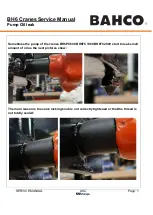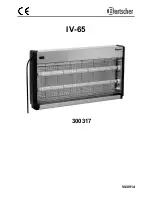
Page
76
of
133
Version 3.0 Rev r000
Date 25-08-2010
Part No. 96000001
8.2.1.1
Standard Land Survey Technique
One of the most accurate methods to determine the gyro error involves the use of standard
recognised land survey techniques. The time and equipment involved requires that a substantial
period be allotted for such a calibration.
•
If possible, the vessel will be berthed alongside a quay or dock that has a survey
benchmark located in close proximity.
•
If a survey benchmark is not located close to the berth, then the surveyor will have
to run a transit from the nearest, suitable, local survey bench mark to establish a
point on the quay that has a well defined position. From this point another point
should be established along the quay to form a baseline.
•
When the vessel comes alongside, all lines should be made as taut as possible. The
gyro should be allowed 2 hours to settle down after the vessel has come alongside.
•
The stern of the vessel should be measured, with a metal tape, to determine the
centre point of the stern. A survey reflector will be placed at this position. Another
survey reflector will be placed exactly at the bow. It will be verified that the
reflectors are accurately placed on the centre line of the vessel by either
measurements or survey techniques.
•
The surveyor will set up on one benchmark; a round of readings will be taken from
the benchmark to the fore and aft reflectors. Simultaneous to this, the survey
personnel will record the gyro heading as it is read by the survey computer. Any
variation between the digital output and the physical gyro reading should be
remedied prior to the commencement of readings. It is recommended that the
personnel on the vessel and the surveyors on the quay be in constant
communication to assist in coordinating the measurements.
•
One round of readings will be considered to be not less than 30 sets, a set being one
reading each from the bow and stern reflectors.
•
Upon completion of the round from benchmark one, the surveyor will move to
benchmark two and repeat the process.
•
Upon the completion of all rounds, from the two benchmarks, the vessel will turn
about. With the vessel, now heading on the reciprocal heading, the gyro will be
allowed at least 1 hour to settle down.
•
When the gyro has been given sufficient time to settle down, a further series of
range and bearing measurements will be made in exactly the same manner as
before.
When all readings are completed, the surveyor will calculate the azimuth between the two survey
reflectors for each set of readings. The azimuth readings will be compared with the headings taken
on board the vessel from the gyro itself. If there has been little or no movement of the vessel, an
average can be taken of the azimuths and for the gyro readings and compared. By calculating the
standard deviation of the readings, the surveyor can determine the degree of movement during the
recording process. If the deviation is greater than the stated accuracy of the gyro, the comparison
readings should be based on simultaneous time.
Summary of Contents for 2022
Page 1: ...SONIC 2024 2022 BROADBAND MULTIBEAM ECHOSOUNDERS Operation Manual V3 0 Part No 96000001 ...
Page 2: ...Page 2 of 133 Version 3 0 Rev r000 Date 25 08 2010 Part No 96000001 ...
Page 92: ...Figure 78 Smooth log information copied from real time survey log ...
Page 96: ...Page 96 of 133 Version 3 0 Rev r000 Date 25 08 2010 This page intentionally left blank ...
Page 112: ...Page 112 of 133 Version 3 0 Rev r000 Date 25 08 2010 This page intentionally left blank ...
Page 116: ...Page 116 of 133 Version 3 0 Rev r000 Date 25 08 2010 This page intentionally left blank ...
Page 125: ...Page 125 of 133 Version 3 0 REV r000 Date 25 08 2010 Figure 94 Sonic 2024 Receive Module ...
















































